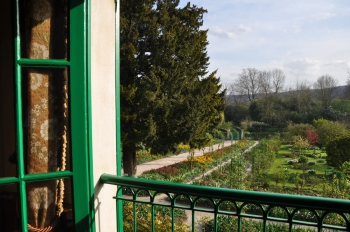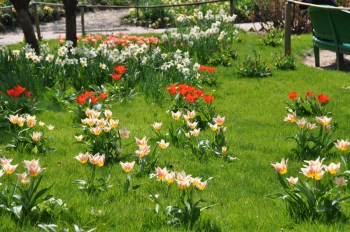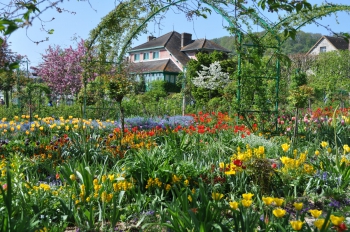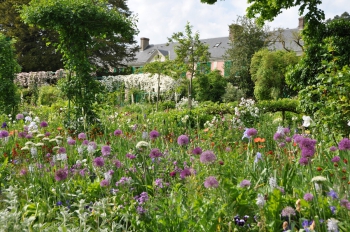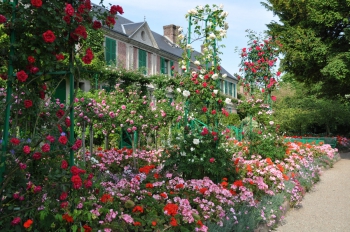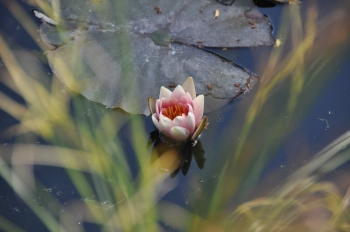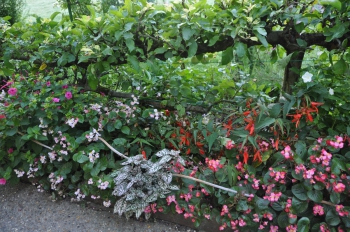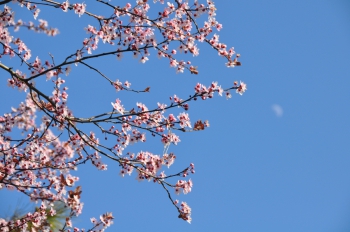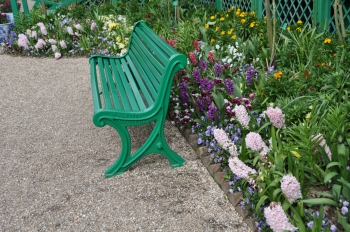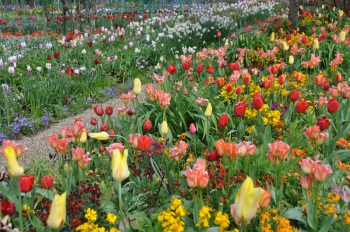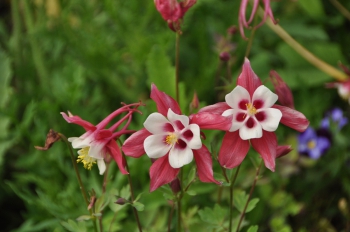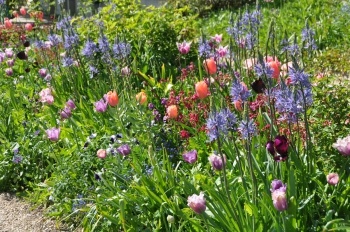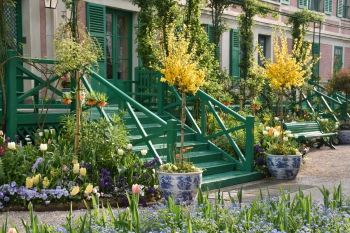This is what Claude Monet could see when he gazed through his bedroom’s window in April. Last year spring was very early and the first colors were already there at the opening of the garden. Wallflowers make a striking effect combined with tulips, while daffodils and jonquils form islands of white and yellow flowers on the lawns. In the distance, the tall trees of the water garden don’t have any leaves yet. It is just a matter of days.
The Early Spring Garden
Opening: 28 March 2015
Monet’s house and gardens at Giverny will open next week on Saturday, the 28th of March 2015. If you plan to explore Monet’s place that early in the season, this is more or less what you can expect. The above pic was taken last year on the 2nd of April.
It is an effect I like and that doesn’t last for a long time, daffodils making bouquets on the fresh green lawn. Their planting recalls the way the water lilies float on the surface of the pond in Monet’s water garden.
In April it is still possible to look over the rose bushes planted all around this patch of lawn. Very soon leaves pop out, the border thickens and hides the lawn behind. In the meanwhile, the daffodils will have faded, so we will be only too happy not to see them anymore…
This Extraordinary Spring Glow
In April, as soon as the sun shines, Monet’s garden radiates. The colors are brighter than ever. Greens are vibrant. Red tulips flame in their complementary color. All the upside down bells of the bulb flowers resemble shiny laterns that have just been switched on.
What is the reason therefore? A freshly washed air, cool enough not to contain any haze? Or is it due to the height of the sun? I don’t know. But it is properly amazing and special to early spring. The glow of April makes you want to come out in the garden, to paint and to photograph.
An Invisible Pattern
Seen on a map or from the windows of his home, Monet’s flower garden aligns straight lines that ressemble almost a grid. But because Monet raised the flower beds, an oblique look through the garden doesn’t reveal the walkways. Instead, it gives the feeling of an endless flowered meadow full of of striking colors. Blues are made by forget-me-not, while tulips, fritillaries and pansies provide all the colors of the painters palette. (Click on picture to enlarge)
Purple and Blue Harmonies
Mid-May, in Monet’s gardens the last tulips that were so colorful are followed by blue and purple flowers: flouncy irises and ball shaped alliums.
Both exist in all sorts of tones from pale to intense.
When planting them, the gardeners pay great attention to their variety, trying not to have two same flowers side by side.
Although they are so numerous, they never produce a mass effect but keep a very natural look, that makes all the charm of Giverny.
Paulownia
In May, a big tree crowns Monet’s flower garden with a beautiful mauve blossom. It is a paulownia, also named princess tree or impress tree. Its color harmonizes with the purples of the alliums in the Norman Enclosure. They combine with the yellows of isatis, their complementary color, for more vibrance.
There is even a more subtle combination. The paulownia is so big that it can be seen from the water garden. It reflects into the pond between the reflections of the wisterias on both sides of the pond. They have exactly the same color and flower the same two weeks, as if they would have organized their annual meeting. Thus they create a connection between the two gardens separate by the road.
The Rose Garden
I hope I will live long enough to experience the time when computers will manage to send fragrances. It would be so nice to be able to share the scents of Giverny. The roses are in full bloom, and their delicate perfume fills in the air. In the water garden, it mingles with the sweet scent of honey suckle, creating a very girly combination, the kind of fragrance I loved to wear as a teenager. I wonder if the teenagers of today still like it. But I see everyday how ladies love smelling flowers. To get most of a peony or an iris, the best is to put one’s nose in the petals. It is so good it gets addictive. Is this a feminine gesture, as a female visitor suggested it to me? I remember a photo of Georges Clemenceau smelling a rose. The Tiger himself! With such an example, gentlemen should feel free to indulge in this pleasure.
The Rose Arches
Water Lily’s Beauty
Claude Monet was never tired of painting his water lilies, because they are ever changing. They open, they close, they float on a mirror that reflects the clouds passing, the sun getting higher and lower in the sky. Monet painted his water lilies relentlessly, almost 300 times.
It is a question that visitors I guide through the gardens ask regularly: “Do you ever get tired of it?” No, never. How could one get tired of beauty?
Flower Border
In Monet’s flower garden at Giverny, a beautiful border covers the feet of the espaliered apple trees.
These colorful cushions are made of begonias boliviensis, whose lovely leaves resemble angel wings, combined with pink begonias semperflorens, four o’clock plants and polka dot plants.
The latter is often used in planters but it is also a very nice ground cover, that brings color and doesn’t need deadheading.
According to a keen gardener I met, polka plants are ‘the best thing since sliced bread’. It was the first time I ever heard this funny expression that doesn’t translate into French. Well, you can translate word for word, but it is not a colloquialism and I can’t think of any equivalent.
This is great with foreign languages: you keep learning as long as you talk with native speakers, and sometimes you remember how it felt when you were six and wouldn’t understand exactly what people meant.
And this is what I find so great with my job: sharing with avid gardeners, speaking foreign languages, meeting wonderful people, and walking daily in the little Eden designed by Monet. All this combines like the flowers in the flower bed and makes my life happy and colorful. Thank you to you all.
Signs of Spring
The season has officially changed today! To celebrate the arrival of spring, let’s take a walk in Monet’s gardens at Giverny to look for the very first flowers. So far they concentrate in the best exposed borders. As soon as the weather gets a bit warmer, there will be flowers and colors all over the garden, turning the blank sheet into a joyful painting. (click to enlarge the pictures)
Small jonquils line the feet of the espaliered apple trees, and clumps of daffodils flower next to the chickens cage. It is lovely to see them coming back year after year. I’ve heard they can live for over fifty years!
Daisies bloom for Easter, this is why they are called pâquerettes in French, Pâques being Easter. The wild ones love growing into the lawns that they illuminate like little white lights. Horticulturist have improved them to these cute pink or white pompoms. Giverny’s gardeners plant them everywhere in the spring garden. Well, not absolutely everywhere, and certainly not anywhere. In all the places where they fit and match.
Just out of the winter, flowers are small. They didn’t have much time to grow a long stem, or perhaps it is warmer next to the ground, I don’t know. It is time to bend down to admire the little marvels offered by the season before they disappear under more impressive giants. These are the lovely ipheions, also named Spring starflowers – for obvious reasons. At Giverny they can be found next to the left staircase of the Monet house.
In the water garden, some beds combining pansies, daisies and hyacinths are already quite sweet. I suspect these early hyacinths to be purposely forgotten bulbs of last year. Their scent is a delight. The gardeners plant bulbs at different times, they also plant many different varieties to obtain the longest possible blooming time.
And last but not least, this little dwarf tulip opening its petals is enjoying the first ray of sunshine. Tulips will be at their best in five to six weeks, in all shapes and colors. Giverny has an enormous display of tulips of all kinds. An absolutely beautiful tulip show. Late April is one of my favorite times in the garden… followed by several others…
The Ideal Bench
Did you ever try and grow a hyacinth in your kitchen? If so, you certainly remember how fragrant a single bulb is. So imagine being seated on this green bench in Monet’s garden, wrapped by the scent of hundreds of hyacinths… This is an early April rapture at Giverny.
The brand of the bench, le banc idéal – the ideal bench – has nothing to do with the floral wonders of Giverny. But it sounds appropriate, doesn’t it?
The Big Tulip Show
In late April, Monet’s flower garden at Giverny shimmers of the colors of thousands of tulips and other spring bulbs. Used like little dots of paint on a canvas, their planting is so subtle that it combines mass effect and delicacy.
The Grand Alley sports patches of fresh colors.
The ‘paint-box’ aligns little beds of pure colors side by side, like tubes of paint in an artist box. The result is a rainbow framed by the trellis.
Delicate, dainty? Forget-me-not needs some popping red in order not to look twee.
On the western side of the flower garden, rows of tulips recall the tulips fields in Holland that Monet loved and painted. The colors chosen for this side of the garden are those of sunset: yellow, orange and red.
The Flowers of Mid-May
After tulips, what kind of flowers steel the show at Giverny? Among my favorite are aquilegias, for their delicacy, strange shapes and wide range of colors including white and black, yellow and blue, and pink. Their light foliage is a beauty.
Camassias are late spring bulbs that grow rather tall.
Pink tree peonies are short lasting little wonders,
just like this one that looks more modern.
Irises are just starting.
The vines are at their best. Here the wisterias over the Japanese footbridge,
And the Clematis montana covering the trellises in the flower garden.
Giverny in June
In June, all the water lilies flower on Monet’s pond, beautiful and delicate corollas in different tones of pink and soft yellow or white.
The foxgloves stand out everywhere in the garden, like giant sentinels that tower far above our heads.
The long lasting columbines team with other small flowers like geums and catchfly to offer a light foam of little dots of color. Elsewhere, annual poppies turn the garden pink or red.
June is the month of roses. At Giverny they stand or climb on dozens of metallic structures or on fences. Their scent is a delight…
The Flowers of September
September is a magic time at Giverny. In Monet’s gardens, all the summer flowers had ample time to settle and offer generously their fascinating beauty. It is an endless surprise to discover the latest varieties of giant dahlias, picked out from the thousands of existing cultivars. They combine in the pink border above with cleomes, sages, zinnias, roses and ageratums, displaying all the different tones from pale pink to deep purple.
In yellow beds, it is time for huge sunflowers of all kinds, coreopsis and black eyed Susan, anthemis, and for some contrast the strange shapes of amaranthus caudatus, whose common name I’m not so fond of: ‘Love lies bleeding’.
This sad name is certainly not in tune with the atmosphere of flowery feast that reigns in the Giverny garden. The alleys are full of lovers that walk hand in hand with a happy smile on their faces. The borders are so high in this season that they provide intimacy. It is a wonderful experience to feel merged in flowers.
A Feast of Colors
Is it worth visiting Monet’s gardens in October? Yes it is!
While the other gardens open to the public have closed or are already preparing their winter borders, at Giverny the fall flowers are at their best.
They have been patiently selected for their longevity to last till the end.
If frost waits for a few more weeks as it is suppose to do, the show will go on until closing day (November 1st).
It Is Not Easy To Look Random
What is so different and appealing with Monet’s flower garden is its very natural look. The gardeners apply themselves to avoid that flowers seem regimented.
It is not as simple as it sounds. We as humans have a tendency to organize. Spontaneously, unconsciously, what we do and make turns out to be regular.
One of the gardeners’ trick for planting bulbs randomly is to throw them on the ground, the bare ground of late Autumn. Where the bulb fell, there it is planted.
This tip works for camassias or tulips. Biennals are planted by color patches that combine different varieties, wallflowers, pansies, violas… Sizes, shapes and hues of the same color help creating the impressionist brushstrokes feeling.
This Time of Year Again
It is this time of year again. Already! At last! The beginning of spring. The time of primroses.
They flower in big cushions along the paths, so pretty that they look cultivated. What! Nature offers these lovely bunches of pinks and yellows for free, to please our eyes and feed the bees! A present of springtime, that has so many to give away.
We may cherish the flowers of summer, but the first ones are the dearest. Monet also must have been moved by the beauty of the primroses, because he didn’t want them to be pulled out for the sheer reason that they are wild and common. Instead, he asked his gardeners to plant around them.
This is still done at Giverny. Lovely wild flowers enhance borders of spring bulbs and biennials. They are one of the tips and tricks used by Monet, an accomplished gardener, to make his garden look more natural.
